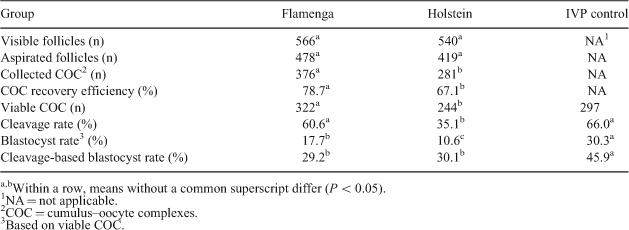230 OVUM PICKUP–IN VITRO PRODUCTION EFFICIENCY FOR CONSERVATION OF THE FLAMENGA CATTLE BREED
F. C. Zago A B , S. Gaudêncio Neto B , L. H. Aguiar B , L. F. Schutz B , F. Forell B , L. R. S. Marinho B , J. MachadoA Agropecuary Research and Rural Extension Company of Santa Catarina State (EPAGRI), Lages, SC, Brazil;
B Center of Agronomy and Veterinary Sciences, Santa Catarina State University (UDESC), Lages, SC, Brazil;
C School of Medicine, University of Fortaleza (UNIFOR), Fortaleza, CE, Brazil
Reproduction, Fertility and Development 23(1) 213-214 https://doi.org/10.1071/RDv23n1Ab230
Published: 7 December 2010
Abstract
The introduction of more specialised and productive dairy breeds into commercial herds in recent decades has caused a gradual loss of interest in dual-purpose cattle breeds, such as the Flamenga. Because of its importance to biodiversity, the high risk of loss of this small Brazilian herd, located in one geographic region in Southern Brazil, justifies the need for and efforts in genetic conservation of the Flamenga breed. The ovum pickup (OPU) procedure is a potential tool for such conservation purposes. Thus, the aim of this study was to evaluate the oocyte and embryo yield potential of the Flamenga breed, as compared with Holstein control counterparts, after in vivo oocyte retrieval followed by in vitro embryo production (IVP). Four Flamenga and 4 Holstein multiparous milking cows from the same herd were subjected to weekly ultrasound-guided OPU sections for 10 consecutive weeks. The number of visible follicles per ovary per female was recorded before the aspiration of ≥3-mm follicles. Retrieved cumulus–oocyte complexes (COC) were morphologically graded according to the method of (Leibfried and First 1979 J. Anim. Sci. 48, 76–86), and viable COC (Grades I, II, and III) from both breeds and from slaughterhouse ovaries (IVP controls) were used for the IVP of embryos, based on our established procedures (Vieira et al. 2002 Cryobiology 45, 91–94). Frozen semen from the same Flamenga breed bull was used in all groups. Quantitative (visible and aspirated follicles, collected COC), and qualitative (COC recovery efficiency, cleavage and blastocyst rates) data were compared between breeds and IVP controls (when pertinent) by Student’s t-test and chi-square test, respectively, for P < 0.05. Results are presented in Table 1. The pools of visible and aspirated follicles were similar between breeds. However, the COC recovery efficiency was higher for Flamenga than for Holstein females. In vitro embryo development was also different between breeds, with cleavage rate being significantly lower for Holsteins than for Flamenga and IVP controls. Blastocyst rates also differed between treatments. Nonetheless, development to the blastocyst stage, when based on cleavage, was similar between Flamenga and Holstein embryos, but with both breeds being lower than the IVP controls. Oocyte quality was likely the cause of such differences in embryo developmental potential between groups, with Flamenga females yielding more oocytes and IVP embryos than Holstein cows. In summary, the use of OPU-IVP procedures was demonstrated to be suitable for the preservation of the Flamenga breed in Southern Brazil.

|
This study was supported by CAPES and CNPq/Brazil.


